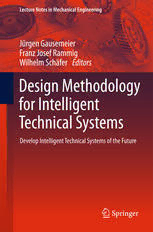Table Of ContentLecture Notes in Mechanical Engineering
Jürgen Gausemeier
Franz Josef Rammig
Wilhelm Schäfer Editors
Design Methodology
for Intelligent
Technical Systems
Develop Intelligent Technical Systems of the Future
Lecture Notes in Mechanical Engineering
Forfurthervolumes:
http://www.springer.com/series/11236
AboutthisSeries
Lecture Notes in Mechanical Engineering (LNME) publishes the latest develop-
mentsinMechanicalEngineering-quickly,informallyandwithhighquality.Orig-
inal research reported in proceedings and post-proceedings represents the core
of LNME. Also considered for publication are monographs, contributed volumes
and lecture notesof exceptionallyhigh quality and interest. Volumespublishedin
LNMEembraceallaspects,subfieldsandnewchallengesofmechanicalengineer-
ing.Topicsintheseriesinclude:
• EngineeringDesign
• MachineryandMachineElements
• MechanicalStructuresandStressAnalysis
• AutomotiveEngineering
• EngineTechnology
• AerospaceTechnologyandAstronautics
• NanotechnologyandMicroengineering
• Control,Robotics,Mechatronics
• MEMS
• TheoreticalandAppliedMechanics
• DynamicalSystems,Control
• FluidMechanics
• EngineeringThermodynamics,HeatandMassTransfer
• Manufacturing
• PrecisionEngineering,Instrumentation,Measurement
• MaterialsEngineering
• TribologyandSurfaceTechnology
·
Jürgen Gausemeier Franz Josef Rammig
Wilhelm Schäfer
Editors
Design Methodology
for Intelligent
Technical Systems
Develop Intelligent Technical
Systems of the Future
ABC
Editors
JürgenGausemeier WilhelmSchäfer
ProductEngineering SoftwareEngineering
HeinzNixdorfInstitute HeinzNixdorfInstitute
UniversityofPaderborn UniversityofPaderborn
Paderborn Paderborn
Germany Germany
FranzJosefRammig
DesignofDistributedEmbeddedSystems
HeinzNixdorfInstitute
UniversityofPaderborn
Paderborn
Germany
ISSN2195-4356 ISSN2195-4364 (electronic)
ISBN978-3-642-45434-9 ISBN978-3-642-45435-6 (eBook)
DOI10.1007/978-3-642-45435-6
SpringerHeidelbergNewYorkDordrechtLondon
LibraryofCongressControlNumber:2013956527
(cid:2)c Springer-VerlagBerlinHeidelberg2014
Thisworkissubjecttocopyright.AllrightsarereservedbythePublisher,whetherthewholeorpartof
thematerialisconcerned,specificallytherightsoftranslation,reprinting,reuseofillustrations,recitation,
broadcasting,reproductiononmicrofilmsorinanyotherphysicalway,andtransmissionorinformation
storageandretrieval,electronicadaptation,computersoftware,orbysimilarordissimilarmethodology
nowknownorhereafterdeveloped.Exemptedfromthislegalreservationarebriefexcerptsinconnection
with reviews or scholarly analysis or material supplied specifically for the purpose of being entered
and executed on a computer system, for exclusive use by the purchaser of the work. Duplication of
this publication or parts thereof is permitted only under the provisions of the Copyright Law of the
Publisher’slocation,initscurrentversion,andpermissionforusemustalwaysbeobtainedfromSpringer.
PermissionsforusemaybeobtainedthroughRightsLinkattheCopyrightClearanceCenter.Violations
areliabletoprosecutionundertherespectiveCopyrightLaw.
Theuseofgeneraldescriptivenames,registerednames,trademarks,servicemarks,etc.inthispublication
doesnotimply,evenintheabsenceofaspecificstatement,thatsuchnamesareexemptfromtherelevant
protectivelawsandregulationsandthereforefreeforgeneraluse.
Whiletheadviceandinformationinthisbookarebelievedtobetrueandaccurateatthedateofpub-
lication,neithertheauthorsnortheeditorsnorthepublishercanacceptanylegalresponsibilityforany
errorsoromissionsthatmaybemade.Thepublishermakesnowarranty,expressorimplied,withrespect
tothematerialcontainedherein.
Printedonacid-freepaper
SpringerispartofSpringerScience+BusinessMedia(www.springer.com)
Preface
TheCollaborativeResearchCentre614"Self-OptimizingConceptsandStructures
in Mechanical Engineering",funded from 2002 to 2013 by the German Research
Foundation(DFG)hasfocusedvanguardproductsforfuturemarketsthatarechar-
acterizedbythecloseinteractionofmechatronicswithinformationandcommuni-
cationtechnology.TheCRC614combinesthegreateststrengthsoftheUniversity
of Paderbornand the Heinz Nixdorf Institute, the symbiosis of computer science,
engineering and mathematics. This is visible by the strong expertise in the field
of mechatronicsin conjunction with optimization. Our focus was on mechatronic
systemswithinherentpartialintelligencethathavecognitivefunctions.
Our vision has been a design methodology for such systems. The CRC 614
has been pursuing the long-term aim of opening up the active paradigm of self-
optimizationfor mechanicalengineeringand also enablingothersto developself-
optimizingsystems. Facinga largespanofaspectsandissues,an interdisciplinary
working group was funded – the interest group self-optimization (IG SO) – to
bringtogetherthemanythoughtsandbasicconceptsandintegrateit intoa design
methodologyforself-optimizingsystems.Thepresentbooksummarizestheresults
of eleven yearsof research.It is one of two booksthat were created at the end of
theCRC 614.Thebook“DependabilityofSelf-optimizingMechatronicSystems”
focuseson tools and methodsto ensure the dependabilityof these systems during
developmentandrun-time.
TheresultsoftheCRC614representamajormilestoneonthewaytointelligent
technicalsystems. While youare readingthe presentbook,we are in the midstof
thedevelopmentofconceptsandmethodsinfollow-onprojectsforexampleforthe
industry4.0.Pleasecontactus,ifyouhaveanyquestionsorcontributionstodiscuss.
Furthermorewewouldliketoinviteyoutoourvirtualexhibitionandtoexploreour
CRC614interactively(www.sfb614.de/en).
YourCRC-Team
Paderborn, Prof.Dr.-Ing.JürgenGausemeier
October2013 SpeakeroftheCollaborativeResearchCentre614
Acknowledgements
ThisbookwaswrittenwithinthecontextoftheCollaborativeResearchCenter614
"Self-OptimizingConceptsandStructuresin MechanicalEngineering",whichhas
beenfundedbytheDeutscheForschungsgemeinschaft(DFG).
It is testimony for the exemplary interdisciplinary collaboration and the team
spirit.InthenameofallmembersoftheCRC 614wewanttothankthemembers
oftheinterestgroupself-optimization(IGSO)andtheauthorsaswellasthemany
not mentioned discussion partner, without whom the book would not have been.
SpecialthankstoMrs.Dipl.-Wirt.-Ing.MareenVaßholz,whowascoordinatingthe
developmentofthebook,tothecoordinatoroftheIGSOMr.Dipl.-Inform.Oliver
SudmannaswellastoDr.ThomasDitzingerandhisteamfromSpringer-Verlag.
Contents
1 TheParadigmofSelf-optimization.............................. 1
1.1 FromMechatronicstoIntelligentTechnicalSystems........... 2
1.2 IntroductiontoSelf-optimization ........................... 5
1.3 ArchitectureofSelf-optimizingSystems ..................... 8
1.3.1 StructureofSelf-optimizingMechatronicSystems..... 8
1.3.2 Operator-Controller-Module ....................... 10
1.4 Self-optimizationinIntelligentTechnicalSystems............. 12
1.4.1 Model-BasedSelf-optimization..................... 12
1.4.2 Behavior-OrientedSelf-optimization ................ 16
1.4.3 Self-optimizationbyReconfiguration................ 19
1.5 StructureofThisBook.................................... 22
References.................................................... 23
2 ExamplesofSelf-optimizingSystems ............................ 27
2.1 RailTechnology–RailCab ................................ 27
2.1.1 Self-optimizingOperatingPointControl ............. 29
2.1.2 intelligentDriveModule(iDM)..................... 33
2.1.3 ActiveGuidanceModule .......................... 36
2.1.4 ActiveSuspensionModule......................... 38
2.1.5 HybridEnergyStorageSystem(HES) ............... 42
2.1.6 CrosslinkedTestBenches.......................... 46
2.1.7 ConvoyMode ................................... 49
2.2 MiniatureRobotBeBot ................................... 50
2.2.1 BasicVehicle.................................... 50
2.2.2 ExtensionModules ............................... 51
2.2.3 OperatingSystem ................................ 53
2.2.4 ImplementingSelf-XProperties .................... 54
2.3 X-by-WireTestVehicle ................................... 56
2.3.1 VehicleDynamics ................................ 57
2.3.2 Self-optimizingIntegratedVehicle-DynamicsControl.. 58
References.................................................... 61
X Contents
3 DevelopmentofSelf-optimizingSystems ......................... 65
3.1 DesignMethodologyforSelf-optimizingSystems............. 66
3.2 Domain-SpanningConceptualDesign ....................... 69
3.3 Domain-SpecificDesignandDevelopment................... 74
3.3.1 MechanicalEngineering........................... 76
3.3.2 ControlEngineering .............................. 78
3.3.3 SoftwareDevelopment ............................ 82
3.3.4 ElectricalandElectronicEngineering................ 88
3.3.5 (Sub)systemIntegration ........................... 91
3.3.6 Interactionof the Domains in the Design and
Development .................................... 93
3.4 Self-optimizingDevelopmentProcess ....................... 96
3.4.1 FrameworkofaSelf-optimizingDevelopment
Process ......................................... 96
3.4.2 SystematicPlanningofSynchronizations............. 105
References.................................................... 113
4 MethodsfortheDomain-SpanningConceptualDesign ............ 117
4.1 SpecificationTechniqueCONSENSfortheDescriptionof
Self-optimizingSystems .................................. 119
4.2 SoftwareSupportfortheSpecificationofthePrinciple
Solution ................................................ 127
4.3 ConsistencyAnalysisofApplicationScenarios ............... 129
4.4 DesignoftheSystemofObjectives ......................... 133
4.5 DesignFrameworkfortheIntegrationofCognitiveFunctions
BasedonSolutionPatterns ................................ 139
4.5.1 SystemsAnalysis ................................ 139
4.5.2 FunctionalDescription ............................ 141
4.5.3 SolutionSelection................................ 143
4.5.4 SystemsSpecification............................. 147
4.6 ProductStructuringforSelf-optimizingSystems .............. 154
4.7 EarlyProbabilisticReliabilityAnalysisBasedonthePrinciple
Solution ................................................ 162
4.8 EvaluationoftheEconomicEfficiency ...................... 171
References.................................................... 180
5 MethodsfortheDesignandDevelopment........................ 183
5.1 AutomaticModelTransformationandSynchronization......... 186
5.1.1 ExampleScenario ................................ 186
5.1.2 DerivingInitialDomain-SpecificModelsfromthe
SystemModel ................................... 188
5.1.3 SynchronizingModelsduringtheDomain-Specific
RefinementPhase ................................ 193
5.2 SoftwareDesign ......................................... 197
5.2.1 ComponentModel................................ 198
Contents XI
5.2.2 DecomposeCommunicationRequirements ........... 199
5.2.3 Real-TimeCoordinationPatterns ................... 200
5.2.4 DiscreteBehavior ................................ 210
5.2.5 SimulationofHybridBehavior ..................... 220
5.2.6 SpecificationofDeployment ....................... 221
5.2.7 IntegrationofSelf-healingBehavior................. 221
5.2.8 CodeGeneration ................................. 222
5.3 SystemOptimization ..................................... 222
5.3.1 Set-OrientedMultiobjectiveOptimization ............ 224
5.3.2 HierarchicalMultiobjectiveOptimization ............ 229
5.3.3 HierarchicalModelingofMechatronicSystems ....... 232
5.3.4 ParametricMultiobjectiveOptimization.............. 236
5.3.5 ComputationofRobustParetoPoints................ 237
5.3.6 OptimalControlofMechanicalandMechatronic
Systems ........................................ 239
5.3.7 MotionPlanningwithMotionPrimitives ............. 244
5.3.8 HierarchicalHybridPlanning ...................... 246
5.3.9 StatisticalPlanning ............................... 250
5.3.10 BehaviorPlanninginNondeterministicEnvironment... 253
5.3.11 FIPAConformCross-DomainCommunication........ 257
5.3.12 PreparingSolutionPattern"HybridPlanning"......... 261
5.4 DynamicReconfiguration ................................. 265
5.4.1 Fine-GrainedReconfigurableArchitectures........... 265
5.4.2 Coarse-GrainedReconfigurableArchitectures......... 267
5.4.3 Modelling....................................... 267
5.4.4 DesignMethodsforDynamicReconfigurable
Systems ........................................ 271
5.4.5 PlatformsandApplications ........................ 279
5.5 SystemSoftware......................................... 291
5.5.1 ArchitectureforSelf-optimizingOperatingSystems.... 293
5.5.2 Self-optimizedFlexibleResourceManagement ....... 297
5.5.3 Self-optimizationintheOperatingSystem............ 299
5.5.4 HierarchicalFlexibleResourceManager ............. 305
5.6 VirtualPrototyping....................................... 310
5.6.1 VirtualPrototypesandVirtualEnvironments.......... 311
5.6.2 AutomaticModelLinking ......................... 313
5.6.3 VisualizationAgents.............................. 320
5.6.4 VirtualTestBench................................ 330
References.................................................... 337
6 SummaryandOutlook ........................................ 351
Index ............................................................ 353

